The iPhone 7 and iPhone 7 Plus Review: Iterating on a Flagship
by Joshua Ho & Brandon Chester on October 10, 2016 8:00 AM EST- Posted in
- Smartphones
- Apple
- Mobile
- iOS
- iOS 10
- iPhone 7
- iPhone 7 Plus
GPU Performance
Section by Brandon Chester
Now that the general system and CPU performance of A10 Fusion has been characterized, we can move on to more focused benchmarks for the GPU and the storage subsystem. Apple's keynote for the iPhone 7 actually disclosed that the GPU in A10 Fusion is a six core part. The last time I recall Apple mentioning specifics about their GPU was with the launch of the iPad 3, where the GPU was advertised as a quad core implementation that turned out to be SGX543MP4.
The use of a six core GPU is interesting because there's not much choice for Apple given that A9 also used the six core PowerVR GT7600. It really boils down to three possibilities. The first is that Apple has actually continued using the exact same GT7600 microarchitecture as on the A9, albeit with an improved layout on the die. The second is that Apple has moved to PowerVR GT7600 Plus, which brings some improvements to integer compute performance, and memory bandwidth optimizations. And the third is the wildcard option - that Apple has put to use its significant GPU engineering resources on a more customized design; something that's still using the PowerVR architecture, but more custom than ever before. This is a longer discussion to have in our full deep dive, but Ryan's of the opinion that this is somewhere between options two and three, that Apple has done some significant work to produce a highly optimized version of the PowerVR GT7600 Plus
In any case, as Apple isn't using a radically different GPU architecture, most of Apple's stated 50% increase in GPU power comes from increasing the clock speeds, with optimizations such as memory and caching picking up the rest. This is interesting because Apple also advertises that A10 Fusion's GPU uses only two thirds the power of A9, which would indicate a lot of work done by Apple to optimize for power usage.


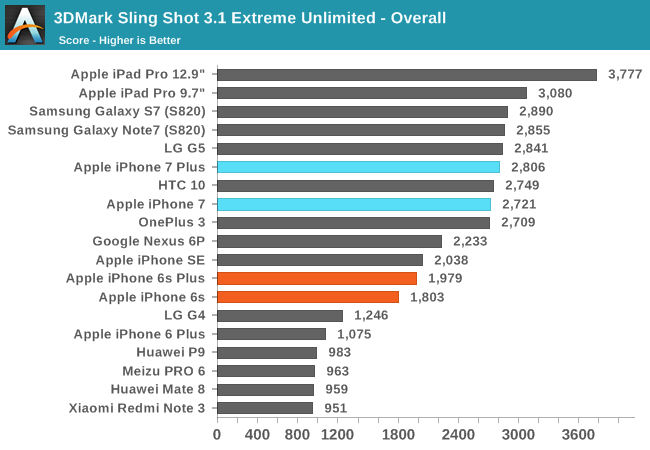
3DMark Sling Shot is broken down into a few different tests, and at the end the results of graphics tests and physics tests produce separate scores which are then used to generate an overall score.
In the graphics test the results are in line with Apple's stated GPU performance improvement of 50%. The physics score, which is really a CPU test, only improves by 30-35%, which has a direct correlation to the increase in peak clock speed from 1.8GHz on A9 to 2.3GHz in A10 fusion.
Like Ice Storm, the physics test is still basically a chart of devices ranked by cores multiplied by max frequency, and you can see that the iPhones have improved very little over the years, with the improvements tracking closely to Apple's increases in CPU clock speed. This comes down to the test being designed in such a way that there's little instruction level parallelism to exploit due to memory dependencies, which puts Apple's wide dual core CPU at a disadvantage. While it is certainly a valid test situation, it's not really reflective of actual 3D game performance because you would generally not write a game in such a way that it cannot exploit the performance of its target hardware.
Even with the smaller improvement in the physics tests, the overall score for the iPhone 7 is still roughly 50% higher than the Apple A9 devices like the iPhone 6s and SE.
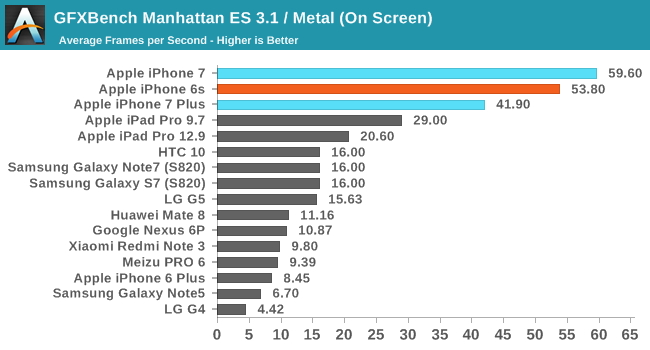
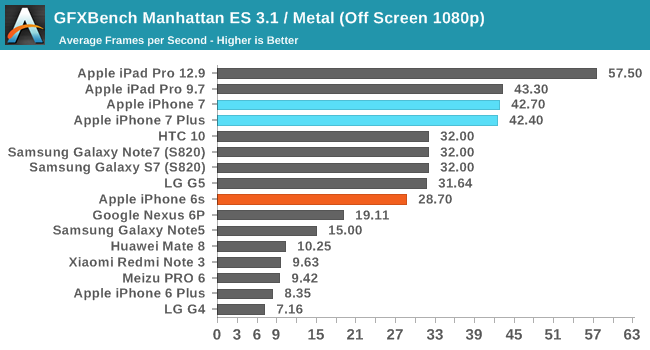
We originally migrated away from Manhattan ES 3.0 to Manhattan ES 3.1 / Metal to push back on devices hitting VSync in the on screen tests. Unfortunately it didn't work for long. With the iPhone 7's increase in GPU performance not being accompanied by an increase in display resolution, the on screen result in GFXBench Manhattan is higher than any other device, and is essentially at the display's refresh limit. The iPhone 7 Plus isn't able to hit Vsync due to its higher resolution, but the on screen result of roughly 42fps is nothing to scoff at either considering the visual complexity of the test.
While on screen performance is helpful from the perspective of someone who wants to see how the phone will actually perform when running a game at its native resolution, to compare directly between devices you need to standardize the rendering resolution. As its name implies, GFXBench's off screen test simply renders all the frames at 1080p in an off screen buffer. In this test the iPhone 7 and 7 Plus both run slightly below 43fps, which puts them right where you'd expect from Apple's claim of 50% greater GPU performance. In GFXBench this also puts the two of them at the same level as the 9.7" iPad Pro for absolute GPU performance.
This gives some interesting insight into the relative clock speeds that Apple is running their GPUs at, as A9X uses a twelve core PowerVR Series7XT GPU, while A10 Fusion uses only six. As I mentioned before, the performance improvements in A10 Fusion primarily come from increasing the peak clock speed. Matching the 9.7" iPad Pro's A9X suggests that Apple has targeted a fairly aggressive clock speed for the GPU in A10 Fusion, and while we can't verify Apple's claim of A10's GPU running at only two thirds the power of A9, if that is indeed the case it would represent a great deal of optimization effort on Apple's part to achieve that despite increasing clock speeds this significantly.
Storage Performance
One of the big changes that came with Apple's A9 and A9X SoCs was a new storage controller designed internally at Apple. This was not the first Apple product to use an in-house SSD controller, as the 2015 MacBook used a PCIe SSD and adopted the NVMe interface. A9 and A9X adapted this for use in mobile, and the sequentual performance in particular was far ahead of anything in a competing mobile device.
Apple hasn't advertised any improvements to storage performance with A10 Fusion, but it's worth running tests to verify that performance has remained at the same level. There are also potential gains in write performance when increasing the total capacity of an SSD by adding additional dies. At this point there's really no benchmark that can give comperable results between iOS and Android, so I've decided against doing a cross-platform comparison here.
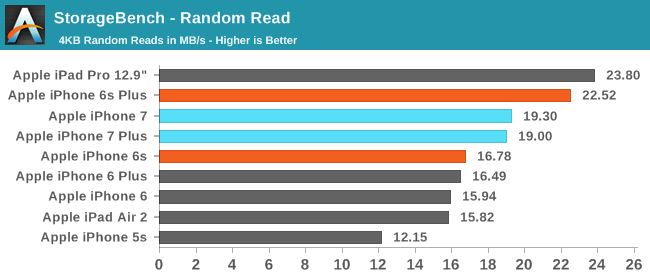
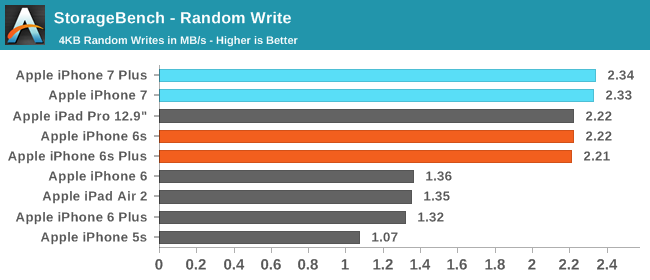

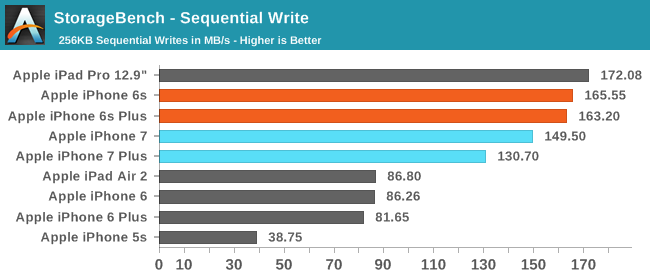
In general, the NAND performance of the iPhone 7 and 7 Plus is equivalent to the iPhone 6s and 6s Plus. There are some minor differences, but essentially all of them can be attributed to testing variance. The only thing that is worth noting is that there's no significant improvement to write performance even though the iPhone 7 units tested are 256GB models while the 6s and 6s Plus were 128GB models. This suggests that the NAND packages use higher capacity dies so there's no additional parallelism to take advantage of.










377 Comments
View All Comments
Matt Humrick - Wednesday, October 12, 2016 - link
"Because: bluetooth is on (and connected to the car), push for email is activated, plenty of applications are activated and running in the background (Whatsapp, Messenger, Skype), location is on, and she is either using the phone doing some internet like facebook or it remains idle, open and close regularly along the 3 hours."Exactly! How are we supposed to test "real life" battery performance when every single person is running different apps, using different screen brightness settings, different mixture of radios on/off, different signal strengths, different use cases, etc. Our battery life tests are not designed to tell you how long YOUR phone will last on a single charge. They are designed to objectively compare one phone to another in an ideal setting. So a phone that lasts 8 hours in our test will generally last longer than another phone that lasts 6 hours given the same workload. The only other option is to run dozens, maybe hundreds, of battery tests all while running different apps, brightness, etc. so that one of them might match up with how a single reader uses their phone.
jlabelle2 - Thursday, October 13, 2016 - link
"How are we supposed to test "real life" battery performance when every single person is running different apps"Let's be real here: I don't think that web browsing 8 hours non stop is representative of ANY single person.
Also, I think that everyone will agree that having Location, Bluetooth (especially on the iPhone 7 pushing BT headset) and email push (which is the default settings) is pretty standard for the majority of users. At last, iMessage working only on Apple devices, which are a minority, it is fair to assume that almost everyone is using AT LEAST one other messaging service.
Bottom line: such battery tests from Anandtech have NEVER been realistic about the real usage as the consumption of the screen, the radio stack and optimization of the OS are not taken into account in a balanced way representative of any users.
GSMArena for instance has 3 values that you can mix depending of your usage. And this make much more sense.
Otherwise, a meaningful test would be having BT, Localization, Push and one messaging app activated, Facebook also (as everyone has that) and a mix of idle + usage case with some browsing, some picture taken and some video. But this battery test is just useless as it favors low consumption screen (where the low resolution of the iPhone has an advantage) and reduce the impact of the connectivity consumption (where the iPhone has no adantage and even trail on an hardware side while having much smaller battery than competition).
Obviously, it would put the iPhone is a much more realistic light which is not following the editorial note of the site...
lilmoe - Tuesday, October 11, 2016 - link
"It is a true workout of display, radio, and SoC, so it's very much a real life benchmark"Oh dear, Ryan, JUST heed the advice. People are slowly realizing that the very benchmarks you're mentioning are absolutely irrelevant in terms of real life scenarios. This is BAD for Anandtech, because just like the op said, these "benchmarks" are dragging you to irrelevance as well.
We criticize because we LIKE this website, not because we hate it. Your stubborn *opinion* isn't helping.
thek - Wednesday, October 12, 2016 - link
''so it's very much a real life benchmark.'' Did you really just say that?!Doesn't a reviewer feel bad or weird when he reviews a phone, provies ''scientific numbers'' such as 8 hours of battery time on wifi loading pages just to use the phone afterwards in real life as a normal user and get 4 max hours of SOT? (and yes, while on wifi loading pages)
There are two issues here:
1. Clearly, everyone can agree that current benchmarks provide completely way off numbers as they *do not* provide a real life case. or else we'd all have 8 hours of SOT on an Iphone. This either needs to be adjusted or removed altogether
2. Companies probably adjust their software to excel in some of these benchmarks in order for you to report it
I'm having a really hard time supporting this site if it bashes good phones like the OP3 because their numbers on the screen benchmakrs were low (while everywhere I looked it was said that the screen is more then fine for a *day to day use for the avarage user*, which is what we're looking for - we're not mechines that can spot the differences) and a site that says that the Iphone7 has a great battery life because the numbers said it while obviously it's incorrect.
You need to understand that right now you are saying if a product is bad or good based on numbers that will back you up. I'm saying that you are blinded by the numbers and they clearly do not show if a product is good or bad.
yipwssg - Tuesday, October 11, 2016 - link
"Apps like WeChat are fairly notorious for holding wakelocks on Android and never really stopping background resource usage " - you have already acknowledge this problem in Android.In real life, Android user will never disable IM application (wechat, LINE , Whatsapp, facebook messenger etc) before surfing net or web browsing.
In the Battery test , why you disable the location and other background services before the test ?
It will be interesting to see how long those Android phones will last with all those background service enable verse iPhone with the same IM application installed.
jlabelle2 - Thursday, October 13, 2016 - link
"In real life, Android user will never disable IM application (wechat, LINE , Whatsapp, facebook messenger etc) before surfing net or web browsing.In the Battery test , why you disable the location and other background services before the test ?"
^^^^^ THIS ^^^^.
A million times. I do not care that the phone is only lasting 4 hours when Anandtech said 8. What I care is how it compares to others. And you cannot tell from this test because the test is very skewed to certain characteristic of the phone (screen consumption, optimization of the web browser and ... that's it).
Anandtech has always insist of how iOS is efficient (which I am not critizing) compared to much bigger battery competitors. B
ut the thing is that once you start to consider real usage, where your phone is not always on (so low density / small screen lower consumption is less a factor) and all the connectivity and push activated like in real life (where efficiency of the modem or GPS or BT module and the battery size have a direct impact), the result is completely different.
ArmedandDangerous - Tuesday, October 11, 2016 - link
Is there a reason why all the HTC 10 RAW photos are at 2s shutter which many times is totally overexposed?JoshHo - Tuesday, October 11, 2016 - link
The images were metered to reach near base ISO at 0 EV. The original DNG files are available if you would like to play with them yourself. The goal was to provide a reference image that could show all detail in the scene.Agent Smith - Tuesday, October 11, 2016 - link
I'm still waiting for Apple to support AptX on their phones?Now if you bear in mind the direction they're going with cordless audio you'd think the iPhone 7 would actually include support and promote this technology? Everyone knows the MacBooks support AptX yet an actual iPhone, that your 'more likely' to use with a cordless device, DOES NOT.
Go figure the Apple logic in that?
dumbnub - Tuesday, October 11, 2016 - link
It's funny, there is this phone reviewer on YT and she always bashes phones for not having accurate colors, she does all the tests with graphs and is always disappointed when they aren't accurate but when she bought a samsung S7 for herself, that has a more natural color mode, which she confirmed is more natural, she uses the default over-saturated mode because she says she prefers it and was like W.T.H. lol. I was always suspect about the whole arguement for natural colors because I loved the screen on the htc m7 and that isn't particularly accurate.